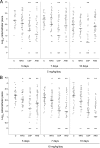Activities of systemically administered echinocandins against in vivo mature Candida albicans biofilms developed in a rat subcutaneous model
- PMID: 23403433
- PMCID: PMC3632894
- DOI: 10.1128/AAC.02288-12
Activities of systemically administered echinocandins against in vivo mature Candida albicans biofilms developed in a rat subcutaneous model
Abstract
This study addresses the effects of micafungin, caspofungin, and anidulafungin against Candida albicans biofilms developed in a subcutaneous catheter rat model system. Doses of 5, 10, and 30 mg/kg (of body weight)/day (the last only for micafungin) were given intravenously for 5, 7, and 10 days. All three echinocandins caused a significant reduction of the Candida cell numbers on the implanted catheters and are thus promising for the treatment of biofilm-related infections.
Figures

Similar articles
-
In vivo efficacy of anidulafungin against mature Candida albicans biofilms in a novel rat model of catheter-associated Candidiasis.Antimicrob Agents Chemother. 2010 Oct;54(10):4474-5. doi: 10.1128/AAC.00697-10. Epub 2010 Jul 26. Antimicrob Agents Chemother. 2010. PMID: 20660685 Free PMC article.
-
Caspofungin at catheter lock concentrations eradicates mature biofilms of Candida lusitaniae and Candida guilliermondii.Antimicrob Agents Chemother. 2014 Aug;58(8):4953-6. doi: 10.1128/AAC.03117-14. Epub 2014 Jun 2. Antimicrob Agents Chemother. 2014. PMID: 24890585 Free PMC article.
-
In vitro efficacies of caspofungin or micafungin catheter lock solutions on Candida albicans biofilm growth.J Antimicrob Chemother. 2008 Jul;62(1):153-5. doi: 10.1093/jac/dkn160. Epub 2008 Apr 10. J Antimicrob Chemother. 2008. PMID: 18407917
-
Antifungal lock therapy.Antimicrob Agents Chemother. 2013 Jan;57(1):1-8. doi: 10.1128/AAC.masthead.57-1. Epub 2012 Oct 15. Antimicrob Agents Chemother. 2013. PMID: 23070153 Free PMC article. Review.
-
Echinocandins: Their role in the management of Candida biofilms.Indian J Med Microbiol. 2018 Jan-Mar;36(1):87-92. doi: 10.4103/ijmm.IJMM_17_400. Indian J Med Microbiol. 2018. PMID: 29735833 Review.
Cited by
-
Candida albicans biofilm development on medically-relevant foreign bodies in a mouse subcutaneous model followed by bioluminescence imaging.J Vis Exp. 2015 Jan 27;(95):52239. doi: 10.3791/52239. J Vis Exp. 2015. PMID: 25651138 Free PMC article.
-
Inhibitory activity of hinokitiol against biofilm formation in fluconazole-resistant Candida species.PLoS One. 2017 Feb 2;12(2):e0171244. doi: 10.1371/journal.pone.0171244. eCollection 2017. PLoS One. 2017. PMID: 28152096 Free PMC article.
-
Antifungal Therapy: New Advances in the Understanding and Treatment of Mycosis.Front Microbiol. 2017 Jan 23;8:36. doi: 10.3389/fmicb.2017.00036. eCollection 2017. Front Microbiol. 2017. PMID: 28167935 Free PMC article. Review.
-
ECIL-6 guidelines for the treatment of invasive candidiasis, aspergillosis and mucormycosis in leukemia and hematopoietic stem cell transplant patients.Haematologica. 2017 Mar;102(3):433-444. doi: 10.3324/haematol.2016.152900. Epub 2016 Dec 23. Haematologica. 2017. PMID: 28011902 Free PMC article.
-
[Chinese expert consensus for invasive fungal disease in patients after hematopoietic stem cell transplantation(2023)].Zhonghua Xue Ye Xue Za Zhi. 2023 Feb 14;44(2):92-97. doi: 10.3760/cma.j.issn.0253-2727.2023.02.002. Zhonghua Xue Ye Xue Za Zhi. 2023. PMID: 36948861 Free PMC article. Chinese. No abstract available.
References
-
- Pappas PG, Kauffman CA, Andes D, Benjamin DK, Jr, Calandra TF, Edwards JE, Jr, Filler SG, Fisher JF, Kullberg BJ, Ostrosky-Zeichner L, Reboli AC, Rex JH, Walsh TJ, Sobel JD. 2009. Clinical practice guidelines for the management of candidiasis: 2009 update by the Infectious Diseases Society of America. Clin. Infect. Dis. 48:503–535 - PMC - PubMed
-
- Shuford JA, Rouse MS, Piper KE, Steckelberg JM, Patel R. 2006. Evaluation of caspofungin and amphotericin B deoxycholate against Candida albicans biofilms in an experimental intravascular catheter infection model. J. Infect. Dis. 194:710–713 - PubMed
-
- Lazzell AL, Chaturvedi AK, Pierce CG, Prasad D, Uppuluri P, Lopez-Ribot JL. 2009. Treatment and prevention of Candida albicans biofilms with caspofungin in a novel central venous catheter murine model of candidiasis. J. Antimicrob. Chemother. 64:567–570 - PubMed
Publication types
MeSH terms
Substances
LinkOut - more resources
Full Text Sources
Other Literature Sources
Medical
Molecular Biology Databases

